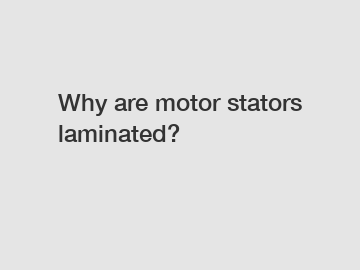Why are motor stators laminated?
CHME are exported all over the world and different industries with quality first. Our belief is to provide our customers with more and better high value-added products. Let's create a better future together.
Have you ever wondered why motor stators are laminated? It may seem like a small detail, but the lamination of stators plays a crucial role in the efficiency and performance of electric motors. In this article, we will explore the reasons why motor stators are laminated and how it benefits the overall functionality of electric motors.
What is a motor stator?

Before diving into why motor stators are laminated, let's first understand what a motor stator is. A motor stator is a stationary component of an electric motor that houses the coils of wire responsible for producing the magnetic field necessary for the motor to function. The stator is a crucial part of the motor as it interacts with the rotor to generate the mechanical motion needed to power various applications.
Why are motor stators laminated?
1. Reduced Eddy Current Losses.
One of the main reasons why motor stators are laminated is to reduce eddy current losses. Eddy currents are currents induced in the conducting material of the stator due to the changing magnetic field generated by the motor. These currents can create energy losses and lead to inefficiencies in the motor's operation. By laminating the stator with thin sheets of electrical steel, the eddy currents are minimized, resulting in improved energy efficiency.
2. Improved Magnetic Properties.
Laminating the stator also improves the magnetic properties of the material. The thin layers of electrical steel act as barriers to eddy currents and help to enhance the magnetic flux within the stator. This optimization of magnetic properties leads to a more efficient conversion of electrical energy into mechanical energy, ultimately improving the overall performance of the motor.
3. Reduced Noise and Vibration.
Another benefit of laminating motor stators is the reduction of noise and vibration during operation. The lamination process helps to dampen vibrations and reduce acoustic noise generated by the motor. This is especially important in applications where noise levels need to be minimized or where smooth and quiet operation is desired.
4. Increased Durability and Longevity.
Laminating the stator also helps to increase the durability and longevity of the motor. The thin layers of electrical steel provide added protection against environmental factors such as moisture and dust, as well as mechanical stresses. This helps to extend the lifespan of the motor and reduce the likelihood of premature failure.
In conclusion, the lamination of motor stators is a critical process that significantly impacts the performance and efficiency of electric motors. By reducing eddy current losses, improving magnetic properties, reducing noise and vibration, and increasing durability, laminated stators play a key role in enhancing the overall functionality of electric motors. If you are interested in learning more about motor stators or are looking for a reliable supplier, feel free to contact us for more information.
Remember, the next time you see a motor in action, take a moment to appreciate the laminated stator that is helping to power it efficiently and effectively.
If you want to learn more, please visit our website.
Contact us to discuss your requirements of custom stamped stator and rotor cores. Our experienced sales team can help you identify the options that best suit your needs.



